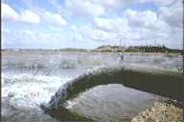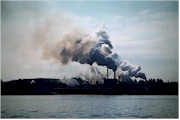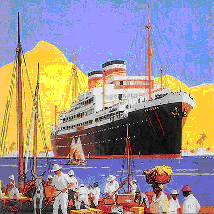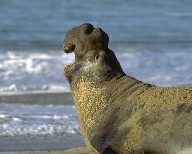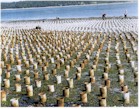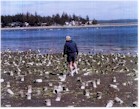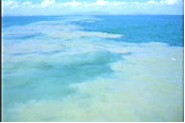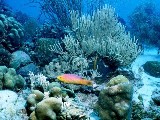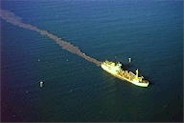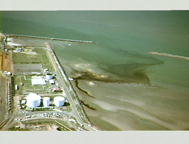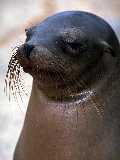|
HUMAN IMPACT ON OCEANS
|
|||||
|
POLLUTING THE OCEAN WATERS AND SHORELINES Acid rain from above
and toxic waste from below.
|
A SEA OF TROUBLES
Abandoned
Seas:
Safeguarding the
|
POLLUTION The ocean absorbs a great amount of carbon dioxide and pollutants, but pollution levels of our whole Earth system are reaching beyond carrying capacity. As human population has increased, so has the deterioration of the world's ocean ecosystems. Two thirds of the major cities in the world are situated along coasts, and millions of people vacation at shorelines. Pollution from developed areas drains into the ocean killing marine life, threatens human health, causes toxic algae blooms, and forces beach closures. Human pollution is destroying coral reefs and coastal habitat which are vital for breeding, food and shelter for marine species. Vast amounts of pollution are draining into our ocean waters daily from human-related activities. Ocean currents can carry pollutants far from the source of entry, and species consume and absorb them. Pollutants have caused major declines in species, and are threatening the planet's ecological stability; and therefore, our life support system.
Sewage,
toxic chemicals, pulp mill and manufacturing wastes, fertilizers, soaps, detergents,
litter and refuse disposal, radioactive wastes,
plastics, oil spills and leaks, runoff, and insecticides are contaminating
our ocean and freshwater sources on a daily basis - far in excess of
what the natural filtering and recycling systems can sustain.
As some hazardous chemicals are banned worldwide and/or locally, many
other new chemicals are developed that continue the harm. |
||||
|
|
Excessive carbon in
the atmosphere from the burning of fossil fuels over the last two
centuries has caused increased acidity in our oceans, which is
threatening ecosystems, sea creatures and their food supplies.
These rising levels of acidity, along with the effects of global
warming, could affect the ability of the oceans to absorb greenhouse
gases. Ocean acidification has already increased the acidity of
the world's oceans to a "level that is irreversible in our life times."
A report from the Royal Society, the UK's leading scientific academy, is
calling upon world leaders to commit to immediate and significant
reductions in carbon dioxide emissions. Continued depletion of
the ozone layer in the upper atmosphere (from chemicals released by
human actions on Earth) could cause a drastic decline in the world's
oceanic plankton. Plankton are tiny organisms floating in vast
numbers in the ocean which are the first link in providing food
supporting marine/sea life. With less protection provided by the
ozone layer, more harmful ultraviolet radiation reaches the Earth.
A decrease in plankton would lead to a domino effect throughout the
aquatic food chain, and severely impact all aquatic species and marine
wildlife. |
||||
|
|
"FLOATING CITIES"
Imagine the cumulative effect of what gets dumped into the sea from ships that carry 4,500 passengers. They are like huge floating cities 10 stories high. If you calculate 600,000 passengers in just one summer season cruising the Alaska's Inside Passage dumping 200,000 gallons of wastewater daily - that's millions of gallons a year. There are many cruise ships throughout the world's waters, all contributing to the massive amounts of pollution impacting ocean health and species. Ships are transporting non-native species and pathogens in their ballast waters and discharging them in waters at destination ports. These exotic species can take over the native species and cause catastrophic changes in marine ecosystems and biodiversity. Many cruise ships fly under "flags of convenience," registering the ships under a variety of foreign countries that have little or no environmental regulation or enforcement of pollution control. Major cruise lines have been fined millions of dollars for falsifying records, installing illegal bypass lines, and dumping oil, sewage, garbage and hazardous toxic wastes into our oceans and waterways. San Francisco Bay has been invaded by Chinese mitten crabs
(that clog irrigation and drinking water pipes), and Asian clams (that
consume large amounts of plankton which other marine species depend
upon). These destructive species and others have come into the Bay
from ballast water that has been dumped by ships coming into port, and
cost more than $40 million in damage every year.
Cruise Ship Fast Facts
(The
Ocean Conservancy) |
||||
|
MARINE
DEBRIS PHOTOS
|
Wildlife are dying from litter and uncontained trash improperly discarded by humans. The gull in the picture to the left starved to death because it became entangled in a plastic container holder that holds canned drinks, such as sodas and beer. Holders such as these should be cut up before properly disposing of them. It is best to remove them and not take them out into nature. Marine animals sometimes mistake debris for food and swallow it or become caught in it and die. Debris and trash can be carried downstream in rivers endangering all aquatic life on its way to the sea where it will drift through the ocean currents for years and years. Plastic floating in the ocean can resemble jellyfish. Many leatherback turtles die from ingesting plastic bags which they mistake for their favorite food, jellyfish. The leatherback is listed on the U.S. Endangered Species List as endangered worldwide. (see our Endangered Species page) Of the approximately 7 billion tons
of litter that enters the world's oceans each year, about 60 percent is
of a plastic composition (Plastics include bags, bottles, strapping
bands, sheeting, synthetic ropes, synthetic fishing nets, floats,
fibreglass, piping, insulation, paints and adhesives). These items
can last for 10-20 years before finally decomposing. It is
estimated that 1 million seabirds and 100,000 other marine animals,
including endangered species, die as a result of having swallowed
plastic litter or been caught in it. Lost and discarded fishing lines and nets cause terrible wounds and suffocation to sea animals. Huge "wall of death" driftnets have entrapped mammals as large as whales and cut into them down to the bone, causing a long painful death from wounds and suffocation. Millions of dolphins have drowned in fishing nets that are set out to catch other fish. These huge fishing nets capture, injure and kill an enormous amount of sealife of all varieties which can't be sold for human food, and the bodies are just tossed back into the ocean.
Planting Plastic in Puget Sound!
Just when you thought you
had seen everything.
|
||||
|
New
Scientist (2/26/02) The Director of the World Wide Fund for Nature's North East Atlantic Programme stated, "These magnificent coral reefs should be off limits for fishing." CNN
Endangered Reefs (Eco-Pros) |
CLEARCUTTING THE OCEAN FLOOR ! Healthy seafloor communities are crucial to maintaining biodiversity in the ocean, yet unregulated trawlers drag huge heavy nets, chains and gear along the bottom of the ocean floor scraping away all life forms and habitat, and destroying vast ecosystems. Ocean bottom inhabitants and marine ecosystems are ripped up, crushed, exposed, and buried, leaving the seafloor looking like an underwater desert. What took centuries, and in some areas thousands of years, to develop is swept up and totally destroyed by one pass of a fishing trawler. Sea corals provide critical habitat for fish and other organisms in marine ecosystems. As much as 70 percent of sealife scraped up in the nets is not "usable" or sought by the trawlers. These dead and dying "non-target" fish and marine animals are tossed back into the ocean. This is referred to as "bycatch," and "trawler trash." Bottom trawling is believed to have caused the decline of major fisheries. Read more about harmful fishing methods in the links provided here and on Endangered Reefs and Great Links pages. "Hoovering" the Ocean According to the Food and Agriculture Organization of the U.N., indiscriminate fishing practices kill and waste between 18 and 40 million metric tons of "unwanted" fish, seabirds, sea turtles, marine mammals, and other ocean life annually - fully one-third of the world catch.
MARINE SCIENTISTS CALL FOR URGENT PROTECTION OF UNIQUE ANCIENT DEEP-WATER CORAL REEFS Deep-water coral systems are being reduced to rubble by heavy towed fishing gear in the Northeast Atlantic. Surviving in the frigid dark waters, these specialized slow-growing corals have formed reefs over thousands of years which give crucial support to hundreds of other species, including valuable fish stocks. New evidence has shown extensive damage to these recently discovered reefs caused by widespread trawling. Dr. Jason Hall-Spencer, and his colleagues videotaped trawled reefs which were left looking like clear-cut forests. The investigative team carbon dated broken coral brought up by trawler's nets fixing the age at 4,500 years old or more. These significant scientific findings were reported in the Proceedings of the Royal Society, UK.
|
||||
|
There has been a 90% decline in Horseshoe
Crabs due to overfishing. Horseshoe crabs are crucial in providing a
food source (crab eggs) for shorebirds migrating from South America to
the Arctic Circle. They are also a vital component in medicine which
saves many lives.
|
Looting the oceans is netting vast sums of money for those countries/industries/individuals that care more about their own greed than they do the global environment or species survival.
HIGH SEAS TASK FORCE
FORMED
Profiting from plundering endangered
species of the ocean OVERFISHING and "Dirty" Fishing
Harpooning the Whale Ban
Alaska
Oceans Program Factory ships from around the world haul fish out of the ocean in huge quantities.
Factory Fishing
(BBC article)
Dynamite - Cyanide Poisoning Fishing Methods: Types described: Beam trawl, Demersal otter trawl, Multi-rig trawl, Dive-caught, Dredging, Drift net, Fish attraction devices, Fish farming, Gill or fixed nets, Handline, Jigging, Trolling, Hand-gathering / picking / collection, Harpoon, Hydraulic dredges, Industrial fishing, Long-lining, Pelagic trawl, Pole and line, Pots / creels, Purse seining, Seine netting, Trap / nets, Use of explosives or poisons. (described by Marine Conservation Society's FishOnline.org) "Dirty" fishing
and overfishing are unsustainable! |
||||
|
Dead oiled sea otter Hard
Aground
Image
gallery |
OIL SPILLS
THE WORST OIL SPILL IN U.S.
HISTORY ENVIRONMENTAL CRISIS
IN THE GALÁPAGOS
Bad Tidings in
Paradise (Time.com photo essay) Oil coats the ocean surface, seabirds, fish, and marine mammals. It washes onshore and destroys shoreline habitat. Vast numbers of plants and animals die, and entire fishing industries have been destroyed. Coastal communities suffer economic damage. Oil damage cleanup costs run into the millions of dollars. Recovery takes years, and some areas will never recover fully. The greatest loss is to the environment and life forms. Since the devastating and widespread Exxon/Valdez spill, improved ship hull designs and additional safety procedures have been implemented for oil-carrying vessels.
|
See our Non-Native Species page for more information on environmental destruction caused by human activities |
| Return to Ocean Home |


